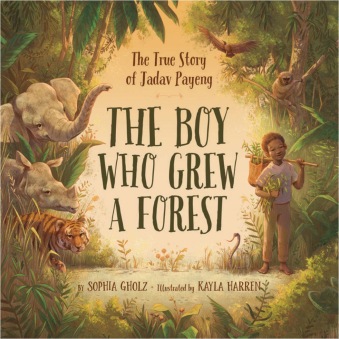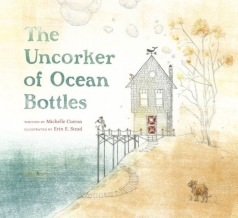Today Sophia Gholz, author of THE BOY WHO GREW A FOREST, gives us a look “behind the scenes” at a few of the finer threads in the fabric of story. Mood, tone, and theme, done well, work seamlessly to ground a story and let the characters and plot shine.
 Mood, Tone, Theme & Story Weaving by Sophia Gholz
Mood, Tone, Theme & Story Weaving by Sophia Gholz
My favorite books are the ones that leave me feeling like I’ve been immersed in a different world or moment in time. Whether I’m swept away on an antlered ship, or hoping a bad seed finds his good side, I love being sucked into a great story. For me, the magic happens when all the components of the story are working—the character, the plot, a satisfying ending—while the mood and tone also stay consistent throughout. There’s nothing more jolting, than reading a book and abruptly being pulled out of it by a word or line. So, how do writers create and maintain a mood that holds strong with every page turn?
As we write, it’s important to focus on character strength, plot arc, and ending. But it’s not just about creating a cool concept or building an interesting plot. It’s about how these different pieces are woven together, and the tools that are used to achieve this. Due to limited word counts, picture book authors have a particular challenge. Each word choice is imperative to achieving thematic goals and maintain the mood. Think of it like this: would Mozart have a sudden guitar solo in the middle of his symphony? Would Monet paint a laughing puppy on his famous water lilies? Even if the guitar solo and laughing puppy were gorgeous pieces in and of themselves, would they make sense to the work of art as a whole? For Mozart, each note blended with the next. For Monet, each paint stroke and color choice were pertinent to that particular painting. Books are the exact same: each word and line must be threaded together in a way that makes sense to the overall mood, tone, and theme of the story.
 There are a lot of tools writers can utilize to help weave their stories in a way that creates mood and maintains tone. For example, patterns can add a consistent structure to your piece. As I wrote The Boy Who Grew A Forest, I used groupings throughout the text to help maintain the pace and the tone. On almost every page, the reader can spot these patterns of three:
There are a lot of tools writers can utilize to help weave their stories in a way that creates mood and maintains tone. For example, patterns can add a consistent structure to your piece. As I wrote The Boy Who Grew A Forest, I used groupings throughout the text to help maintain the pace and the tone. On almost every page, the reader can spot these patterns of three:
…Trees meant shade, food and shelter…
…one shaft, two, then three…
…earth worms, termites, and angry red ants…
…over trails, through brush, down the river…
I also utilized quotes to both start and end the book, then came full circle from the beginning to end with the boy, now a man, “in India, on a large river island”. This patterned structure created a solid and repetitive frame that helped me stick with the same voice throughout. Rhyming texts are often great examples of using structured patterns to help maintain tone and pace.
But if you aren’t rhyming or using patterns, how else might you weave your story components together, while maintaining the mood, tone, and theme? Let’s circle back to the importance of word choice. Pretend we’re writing a story about a child who loves dancing. One of the lines reads like this:
She jumped over puddles as she trotted to school.
How can we make this line beat a little more strongly with the story’s tone and theme? Let’s revise:
She hip-hopped over puddles and tapped her way to school.
By changing a few words, we strengthened our character’s personality and the theme. Perhaps you’re writing a historical nonfiction book about a person who studied the desert. How would you weave the desert theme throughout? Maybe the main character continuously relates emotions to different shades of orange and yellow. Maybe your main character is reminded of the whip of desert winds at different moments in their life.
 In The Uncorker of Ocean Bottles, author Michelle Cuevas does a wonderful job of choosing select phrases that weave her theme throughout:
In The Uncorker of Ocean Bottles, author Michelle Cuevas does a wonderful job of choosing select phrases that weave her theme throughout:
“But most of the time they made people quite happy, for a letter can hold the treasure of a clam-hugged pearl.”
In this line, Cuevas could have used a different metaphor for the message of a letter. However, the use of “the treasure of a clam-hugged pearl” paints a beautiful image that also furthers the wistful tone and oceanic theme.
 Simple phrases or actions can add so much. In Tara Lazar’s Little Red Gliding Hood, the main character, Gliding Hood, continuously repeats the phrase “Oh, slippery slush”. Lazar might have used “Oh, rats!” or “Oh, man!” or anything else. But slippery slush perfectly plays into Gliding Hood’s wintery theme and maintains the playful tone.
Simple phrases or actions can add so much. In Tara Lazar’s Little Red Gliding Hood, the main character, Gliding Hood, continuously repeats the phrase “Oh, slippery slush”. Lazar might have used “Oh, rats!” or “Oh, man!” or anything else. But slippery slush perfectly plays into Gliding Hood’s wintery theme and maintains the playful tone.
When you look at your story, how are your threads falling into place? Is your theme consistent? How about the mood and the tone? Are there areas where you can swap out a few words or tweak the structure? Think about your favorite books. What draws you to them most? Is it just the character? A strong plot? Or is it because you were swept away in the telling of that character’s plot and how the author wove those pieces together? As you revise, pay attention to the in-between—the threads that hold your story together—where the mood, the tone, and theme can thrive.
Sophia Gholz is the owner/operator of Rate Your Story, an incredible site for writers that offers valuable content, as well as opportunities to submit working manuscripts for ratings. Rate Your Story helped me as I revised AN INCONVENIENT ALPHABET, and gave an early version of LIZZIE DEMANDS A SEAT an “honorable mention” in their annual contest.
For a little more on THE BOY WHO GREW A FOREST, see a previous PPBF post HERE.
Love all of the suggestions on wordsmithing, Sophia – what a difference!
LikeLiked by 1 person
I really liked the idea of changing certain words and phrases to fit the theme of the story. I’m in the midst of revising my first draft and I’m going to use that premise as I go forward. Thank you!
LikeLiked by 1 person
This is a great post. Thank you.
LikeLiked by 1 person
Thanks for sharing all your great ideas! 🙂
LikeLiked by 1 person
Thank you Sophia! I will surely relook at all my words, and keep my attention on the flow of every sentence and how it flows. These are great tips.
LikeLiked by 1 person
Wonderfully written post with concrete examples to follow. Thank you!
LikeLiked by 1 person
Great examples! Thanks for sharing them.
LikeLiked by 1 person
Thank you Sophia for the useful advice.
LikeLike
Such a wonderful post. Spot on and such great examples for us as we strive to make our manuscripts the best they can be!
LikeLike
Great examples of careful word choice. Thanks, Sophia, for a thoughtful post!
LikeLike